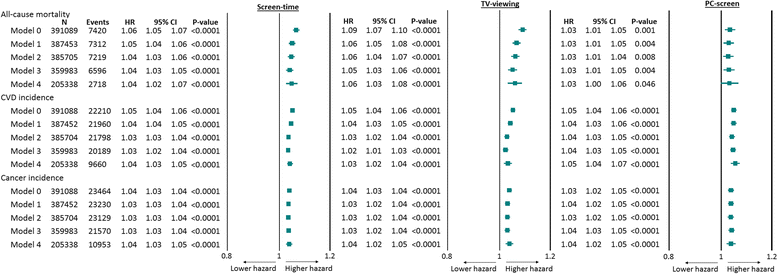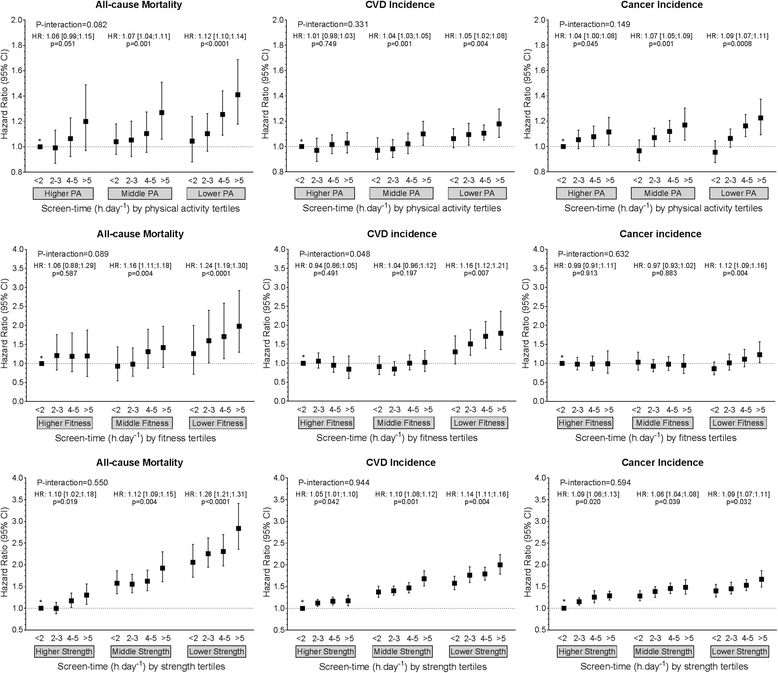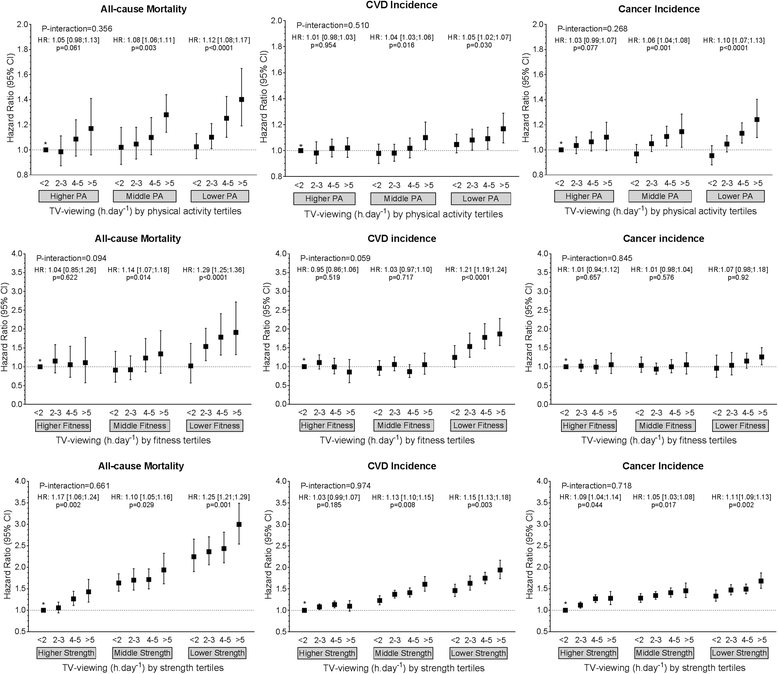Associations of discretionary screen time with mortality, cardiovascular disease and cancer are attenuated by strength, fitness and physical activity: findings from the UK Biobank study
- PMID: 29792209
- PMCID: PMC5966877
- DOI: 10.1186/s12916-018-1063-1
Associations of discretionary screen time with mortality, cardiovascular disease and cancer are attenuated by strength, fitness and physical activity: findings from the UK Biobank study
Abstract
Background: Discretionary screen time (time spent viewing a television or computer screen during leisure time) is an important contributor to total sedentary behaviour, which is associated with increased risk of mortality and cardiovascular disease (CVD). The aim of this study was to determine whether the associations of screen time with cardiovascular disease and all-cause mortality were modified by levels of cardiorespiratory fitness, grip strength or physical activity.
Methods: In total, 390,089 participants (54% women) from the UK Biobank were included in this study. All-cause mortality, CVD and cancer incidence and mortality were the main outcomes. Discretionary television (TV) viewing, personal computer (PC) screen time and overall screen time (TV + PC time) were the exposure variables. Grip strength, fitness and physical activity were treated as potential effect modifiers.
Results: Altogether, 7420 participants died, and there were 22,210 CVD events, over a median of 5.0 years follow-up (interquartile range 4.3 to 5.7; after exclusion of the first 2 years from baseline in the landmark analysis). All discretionary screen-time exposures were significantly associated with all health outcomes. The associations of overall discretionary screen time with all-cause mortality and incidence of CVD and cancer were strongest amongst participants in the lowest tertile for grip strength (all-cause mortality hazard ratio per 2-h increase in screen time (1.31 [95% confidence interval: 1.22-1.43], p < 0.0001; CVD 1.21 [1.13-1.30], p = 0.0001; cancer incidence 1.14 [1.10-1.19], p < 0.0001) and weakest amongst those in the highest grip-strength tertile (all-cause mortality 1.04 [0.95-1.14], p = 0.198; CVD 1.05 [0.99-1.11], p = 0.070; cancer 0.98 [0.93-1.05], p = 0.771). Similar trends were found for fitness (lowest fitness tertile: all-cause mortality 1.23 [1.13-1.34], p = 0.002 and CVD 1.10 [1.02-1.22], p = 0.010; highest fitness tertile: all-cause mortality 1.12 [0.96-1.28], p = 0.848 and CVD 1.01 [0.96-1.07], p = 0.570). Similar findings were found for physical activity for all-cause mortality and cancer incidence.
Conclusions: The associations between discretionary screen time and adverse health outcomes were strongest in those with low grip strength, fitness and physical activity and markedly attenuated in those with the highest levels of grip strength, fitness and physical activity. Thus, if these associations are causal, the greatest benefits from health promotion interventions to reduce discretionary screen time may be seen in those with low levels of strength, fitness and physical activity.
Keywords: Cardiovascular; Fitness; Mortality; Physical activity; Screen time; Screen-time; Strength.
Conflict of interest statement
Ethics approval and consent to participate
The UK Biobank study was approved by the North West Multi-Centre Research Ethics Committee (reference for UK Biobank is 16/NW/0274) and all participants provided written informed consent to participate in the UK Biobank study. The study protocol is available online (
Competing interests
The authors declare that they have no competing interests.
Publisher’s Note
Springer Nature remains neutral with regard to jurisdictional claims in published maps and institutional affiliations.
Figures




Similar articles
-
The association between physical activity and risk of mortality is modulated by grip strength and cardiorespiratory fitness: evidence from 498 135 UK-Biobank participants.Eur Heart J. 2017 Jan 7;38(2):116-122. doi: 10.1093/eurheartj/ehw249. Eur Heart J. 2017. PMID: 28158566 Free PMC article.
-
Associations Between Diabetes and Both Cardiovascular Disease and All-Cause Mortality Are Modified by Grip Strength: Evidence From UK Biobank, a Prospective Population-Based Cohort Study.Diabetes Care. 2017 Dec;40(12):1710-1718. doi: 10.2337/dc17-0921. Epub 2017 Oct 6. Diabetes Care. 2017. PMID: 28986505
-
Understanding How Much TV is Too Much: A Nonlinear Analysis of the Association Between Television Viewing Time and Adverse Health Outcomes.Mayo Clin Proc. 2020 Nov;95(11):2429-2441. doi: 10.1016/j.mayocp.2020.04.035. Epub 2020 Jul 23. Mayo Clin Proc. 2020. PMID: 32713607
-
The Dose-Response Associations of Sedentary Time with Chronic Diseases and the Risk for All-Cause Mortality Affected by Different Health Status: A Systematic Review and Meta-Analysis.J Nutr Health Aging. 2020;24(1):63-70. doi: 10.1007/s12603-019-1298-3. J Nutr Health Aging. 2020. PMID: 31886810
-
Do the associations of sedentary behaviour with cardiovascular disease mortality and cancer mortality differ by physical activity level? A systematic review and harmonised meta-analysis of data from 850 060 participants.Br J Sports Med. 2019 Jul;53(14):886-894. doi: 10.1136/bjsports-2017-098963. Epub 2018 Jul 10. Br J Sports Med. 2019. PMID: 29991570
Cited by
-
[Effects of Television Screen Exposure on the Mental Health of Middle-aged and Older Adults].Sichuan Da Xue Xue Bao Yi Xue Ban. 2023 Nov 20;54(6):1191-1200. doi: 10.12182/20230960504. Sichuan Da Xue Xue Bao Yi Xue Ban. 2023. PMID: 38162069 Free PMC article. Chinese.
-
Association of injury related hospital admissions with commuting by bicycle in the UK: prospective population based study.BMJ. 2020 Mar 11;368:m336. doi: 10.1136/bmj.m336. BMJ. 2020. PMID: 32161038 Free PMC article.
-
Do associations of physical activity and sedentary behaviour with cardiovascular disease and mortality differ across socioeconomic groups? A prospective analysis of device-measured and self-reported UK Biobank data.Br J Sports Med. 2023 Jul;57(14):921-929. doi: 10.1136/bjsports-2022-105435. Epub 2023 Feb 8. Br J Sports Med. 2023. PMID: 36754587 Free PMC article.
-
Dynapenia in all-cause mortality and its relationship with sedentary behavior in community-dwelling older adults.Sports Med Health Sci. 2022 Sep 23;4(4):253-259. doi: 10.1016/j.smhs.2022.09.002. eCollection 2022 Dec. Sports Med Health Sci. 2022. PMID: 36600974 Free PMC article.
-
Genome-wide association studies and Mendelian randomization analyses for leisure sedentary behaviours.Nat Commun. 2020 Apr 21;11(1):1770. doi: 10.1038/s41467-020-15553-w. Nat Commun. 2020. PMID: 32317632 Free PMC article.
References
-
- Wilmot EG, Edwardson CL, Achana FA, Davies MJ, Gorely T, Gray LJ, Khunti K, Yates T, Biddle SJH. Sedentary time in adults and the association with diabetes, cardiovascular disease and death: systematic review and meta-analysis. Diabetologia. 2012;55(11):2895–2905. doi: 10.1007/s00125-012-2677-z. - DOI - PubMed
-
- Kodama S, Saito K, Tanaka S, Maki M, Yachi Y, Asumi M, Sugawara A, Totsuka K, Shimano H, Ohashi Y, et al. Cardiorespiratory Fitness as a Quantitative Predictor of All-Cause Mortality and Cardiovascular Events in Healthy Men and Women A Meta-analysis. JAMA. 2009;301(19):2024–2035. doi: 10.1001/jama.2009.681. - DOI - PubMed
Publication types
MeSH terms
Grants and funding
LinkOut - more resources
Full Text Sources
Other Literature Sources
Medical
Molecular Biology Databases

